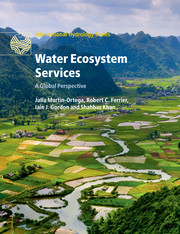Book contents
- Frontmatter
- Contents
- List of contributors
- Preface
- 1 Introduction
- 2 What defines ecosystem services-based approaches?
- Part I Addressing global challenges
- Part II Applying frameworks for water management and biodiversity conservation under an ecosystem services-based approach
- Part III Assessing water ecosystem services
- 9 The first United Kingdom's National Ecosystem Assessment and beyond
- 10 Using an ecosystem services-based approach to measure the benefits of reducing diversions of freshwater: a case study in the Murray-Darling basin, Australia
- 11 An ecosystem services-based approach to integrated regional catchment management: the South East Queensland experience
- 12 Policy support systems for the development of benefit-sharing mechanisms for water-related ecosystem services
- 13 Assessing biophysical and economic dimensions of societal value: an example for water ecosystem services in Madagascar
- 14 Rapid land use change impacts on coastal ecosystem services: a South Korean case study
- Part IV Broadening the perspective
- Index
- Plate Section
- References
10 - Using an ecosystem services-based approach to measure the benefits of reducing diversions of freshwater: a case study in the Murray-Darling basin, Australia
from Part III - Assessing water ecosystem services
Published online by Cambridge University Press: 05 May 2015
- Frontmatter
- Contents
- List of contributors
- Preface
- 1 Introduction
- 2 What defines ecosystem services-based approaches?
- Part I Addressing global challenges
- Part II Applying frameworks for water management and biodiversity conservation under an ecosystem services-based approach
- Part III Assessing water ecosystem services
- 9 The first United Kingdom's National Ecosystem Assessment and beyond
- 10 Using an ecosystem services-based approach to measure the benefits of reducing diversions of freshwater: a case study in the Murray-Darling basin, Australia
- 11 An ecosystem services-based approach to integrated regional catchment management: the South East Queensland experience
- 12 Policy support systems for the development of benefit-sharing mechanisms for water-related ecosystem services
- 13 Assessing biophysical and economic dimensions of societal value: an example for water ecosystem services in Madagascar
- 14 Rapid land use change impacts on coastal ecosystem services: a South Korean case study
- Part IV Broadening the perspective
- Index
- Plate Section
- References
Summary
10.1 INTRODUCTION
Ecosystem services-based approaches have been applied to decisions about trade-offs between alternative uses of land (RaudseppHearne et al. 2010; Maes et al. 2012; Bryan & Crossman 2013; Geneletti 2013; Seppelt et al. 2013), but have been used less commonly to assess trade-offs in alternative uses of water (Schluter et al. 2009; Rouquette et al. 2011; Liu et al. 2013). In this chapter we provide an overview of a case study into quantifying the ecosystem services and associated benefits (and their monetary values) of a new water-sharing plan that will return water to the environment in the Murray-Darling Basin, Australia. This serves as an illustration of how to operationalize an ecosystem services-based approach, as defined in this book. Chapter 2 in this book emphasizes that there is a gap between the conceptualization and endorsement of ecosystem services by both researchers and policy makers and the incorporation of ecosystem services-based approaches into natural resources management practice. The present chapter demonstrates the operationalization of an ecosystem services-based approach in the context of water resource planning and management. We estimate the changes to a range of final ecosystem services (Boyd & Banzhaf 2007; Kumar 2010) that result from the implementation of a discrete policy scenario, and provide economic estimates for the associated benefits. Our work contributes to the still scarce literature on real-world examples of integrating empirical data on the biophysical supply of ecosystem services with their socio-cultural context and monetary valuation to inform investment decisions (Martín-Loópez et al. 2014; see also Mulligan et al., this book).
The Murray-Darling Basin contains iconic and internationally important wetlands and is Australia's major food-producing area. In terms of gross value, about 40% of Australia's agriculture and 50% of irrigated agriculture is produced in the Basin (Australian Bureau of Statistics 2013). However, the dominance of food production has come at the expense of other ecosystem services provided by land and water resources in the Basin, primarily due to the decline in health of river, wetland, and floodplain ecosystems (Kingsford 2000; Kingsford et al. 2011).
Information
- Type
- Chapter
- Information
- Water Ecosystem ServicesA Global Perspective, pp. 82 - 89Publisher: Cambridge University PressPrint publication year: 2015
References
Accessibility standard: Unknown
Why this information is here
This section outlines the accessibility features of this content - including support for screen readers, full keyboard navigation and high-contrast display options. This may not be relevant for you.Accessibility Information
- 3
- Cited by
